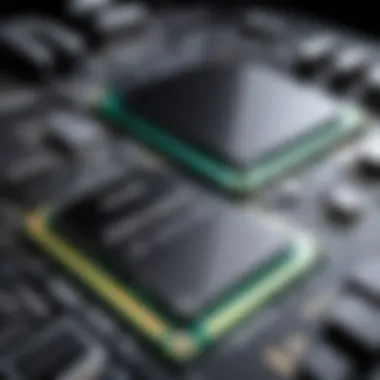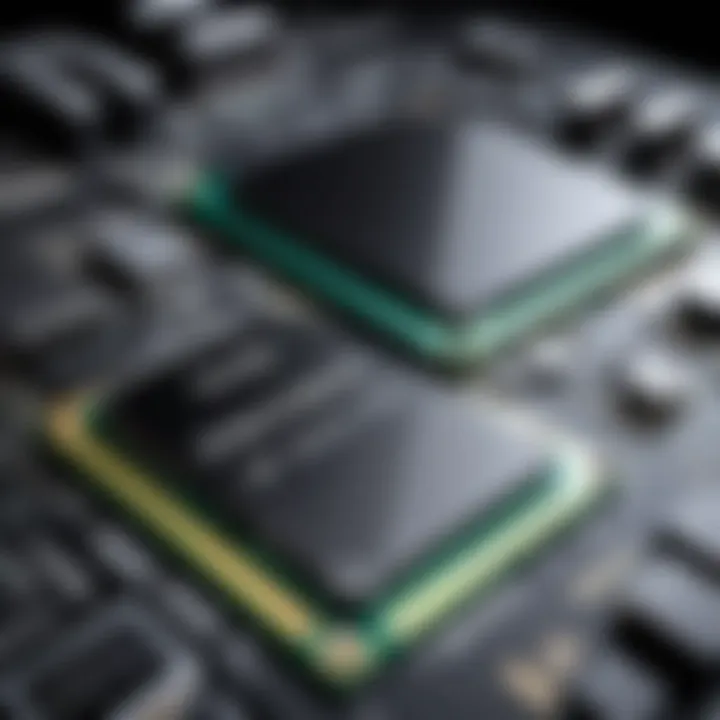Understanding Processor Rate: Key Insights for Users


Intro
Navigating the ever-evolving landscape of computer performance requires a solid grasp of what processor rate means. It's not just numbers on a spec sheet; it's the heartbeat that influences how your machine handles tasks, from mundane word processing to the most demanding gaming sessions. Why should you care about processor rate? Well, it directly translates into the speed and efficiency with which your device operates. This guide aims to clarify the importance of processor rate, highlighting factors that influence it, comparisons between different processors, and its implications in real-world scenarios.
Product Overview
When diving into processor rates, it’s essential to consider specific products and their specifications. For instance, let’s take a closer look at a few notable processors that have made waves in the tech community.
Brand Information
AMD and Intel are the giants in this space. AMD’s Ryzen series has gradually started to rival Intel’s Core processors in both performance and price, making them a firm favorite among tech enthusiasts. Their architectures are tailored to meet the demands of various computing tasks.
Key Specifications
- AMD Ryzen 9 5900X
- Intel Core i9-11900K
- Cores: 12
- Threads: 24
- Base Clock: 3.7 GHz
- Boost Clock: up to 4.8 GHz
- Cores: 8
- Threads: 16
- Base Clock: 3.5 GHz
- Boost Clock: up to 5.3 GHz
Pricing
Pricing can be a dealbreaker. The Ryzen 9 tends to hover around 500 USD, whereas the Core i9 can reach upwards of 600 USD, but both present compelling arguments for the tech-savvy buyer. It’s crucial to weigh the price against performance benefits, especially when considering your specific needs, whether gaming, content creation, or simple multitasking.
Performance Comparison
The heart of our discussion lies in understanding how these processors perform under different workloads.
Benchmark Tests
Real-world benchmarks tell a clearer story of speed than mere specs. For instance, when subjected to multi-threaded tasks, the Ryzen 9 shows exceptional performance, making it ideal for video editing and rendering tasks. In gaming scenarios, the higher clock speeds of the Core i9 often lead to better frame rates, especially in CPU-intensive titles.
Speed and Efficiency Comparisons
When considering efficiency, the Ryzen 9 tends to utilize power more effectively than the Intel counterpart at certain workloads, showcasing a more balanced approach to performance. However, in most typical consumer applications, both processors excel noticeably, leaving gamers and professionals to choose based on specific requirements.
Features and Technology
It's worth examining the unique features that differentiate these processors.
Unique Features
- AMD Ryzen 9 frequently supports higher core counts, which is advantageous for multi-tasking and parallel processing.
- Intel's Thermal Velocity Boost technology dynamically increases the clock speed if the processor is running cool enough, optimizing performance in bursts.
Technological Advancements
AMD has made significant strides with its Zen architecture, promising better power efficiency and optimized performance per watt. Intel, on the other hand, is innovating with its Hybrid technology, which combines high-performance cores with efficiency cores, adapting to workloads seamlessly.
Compatibility with Other Devices
Both brands have made strides in compatibility with emerging technologies. However, AMD’s AM4 socket architecture has opened doors for easier upgrades in future generations without requiring a new motherboard.
Pros and Cons
Every product has its highs and lows.
Strengths of the Product
- AMD Ryzen 9 5900X: Massive multi-threading capabilities and great performance in creative applications.
- Intel Core i9-11900K: Outstanding gaming performance and excellent single-thread performance.
Areas for Improvement
- AMD: Can lag slightly in certain gaming scenarios where high clock speeds have the edge.
- Intel: Higher prices and potential thermal throttling if not cooled sufficiently.


Value for Money
When it comes to the value proposition, assessing cost-effectiveness is paramount. Both processors offer features that are designed to provide long-term advantages.
Cost-Effectiveness
For a cache of features and performance, the Ryzen processor often presents itself as a better deal relative to the power it delivers. In contrast, if pure gaming performance is your only concern, the Intel processor could very well justify its price tag due to the slight edge it holds in that arena.
Long-term Benefits
Assessing long-term benefits is about considering upgrade paths. AMD’s offerings facilitate easier upgrades, while Intel remains robust for now but has a history of socket changes.
Comparison with Similar Products
In summary, understanding the nuances between processors is imperative. Both the AMD Ryzen and Intel Core series pave the way for varying user needs, both promising prolific performance but belonging to slightly different philosophies.
Understanding the processor rate is not just about picking the latest model; it’s about considering your usage scenario and the long-term implications of your choice.
The Fundamentals of Processor Rate
Understanding processor rate is paramount for anyone diving into the world of technology today. It acts as a cornerstone for gauging computer performance, affecting everything from how swiftly applications run to how fluidly games play. A strong grasp of this concept enables IT professionals and tech enthusiasts alike to make informed decisions when purchasing hardware or optimizing systems.
Defining Processor Rate
Processor rate refers to the speed at which a processor can execute instructions, often represented in gigahertz (GHz). The higher the GHz, the more operations a processor can complete in a given time frame. However, it’s important to note that processor speed isn't the only factor at play—other metrics come into the picture, shaping the overall capability of the CPU.
To put this in a context, imagine trying to fill buckets with water using different-sized hoses. A wider hose (higher GHz) will fill the bucket faster (execute tasks quicker), but if the faucet that supplies water (overall architecture and technology) isn't efficient, it won't matter how wide the hose is; it will have limitations.
Importance in Computer Performance
The relevance of processor rate in computer performance cannot be overstated. An efficient processor that operates at a high rate can significantly enhance productivity, particularly in computational tasks such as video rendering or complex calculations.
Conversely, if individuals opt for underpowered processors, they may face lag or delays that dampen their experience, especially in activities such as gaming or software development.
- In gaming, the processor rate heavily influences frame rates and loading speeds, creating a smoother experience with minimal stuttering.
- In productivity applications, processor speed can expedite operations, reducing waiting times and allowing users to switch between tasks effortlessly.
- For multitasking scenarios, a higher processor rate means more processes can run simultaneously without a noticeable dip in performance.
In summary, grasping the fundamentals of processor rate isn’t just a technical curiosity; it provides valuable insights into the essential mechanics of performance—whether for leisure or professional tasks.
"A computer is only as powerful as the instructions it can process quickly."
Measurement Metrics for Processor Rate
When it comes to grasping processor rate, measurements play a pivotal role. Understanding how to quantify a processor's capabilities can significantly influence many decisions, from selecting hardware for daily tasks to refining a high-performance gaming rig. The metrics provide insight into not just speed but also overall efficiency, guiding users toward informed choices based on their unique needs. This section zeroes in on the key elements that shape processor rate measurements, emphasizing why they matter in the realm of technology.
Clock Speed and Its Role
Clock speed often holds top billing when discussing processor performance. Measured in gigahertz (GHz), it indicates how many cycles a processor executes per second. A higher clock speed typically suggests that the processor can handle more tasks in a shorter amount of time. However, it's crucial not to take this figure at face value. For instance, a processor with a clock speed of 3.5 GHz may appear more powerful on paper than one clocked at 3.0 GHz. But if the latter has superior architecture and better core design, it could outperform the former in real-world applications.
It's worth noting that clock speed isn't everything. Factors such as thermal throttling can lead to a drop in performance when the chip gets too hot. More advanced cooling solutions can help maintain consistent speeds, but users must consider that an impressive clock speed doesn't automatically guarantee superior performance in every scenario.
Core Count and Threads
In today's computing landscape, the number of cores and threads is another significant metric impacting processor rate. A core is capable of executing tasks independently, while threads can be seen as virtual cores that allow a single core to manage multiple tasks. More cores usually mean better multitasking capabilities. For example, a quad-core processor can dedicate four processing threads to different tasks at once, thus handling multiple applications more smoothly than a dual-core processor.
However, sheer core count isn’t the only consideration. Software optimization plays a critical role. Programs designed to leverage multiple threads can significantly benefit from additional cores. In contrast, applications that don't take advantage of multithreading may not see any gains, leading to an underutilization of those extra cores.
Floating Point Operations per Second (FLOPS)
Floating Point Operations per Second (FLOPS) measures how many calculations a processor can perform regarding high-precision numbers. This metric is especially important in fields requiring complex mathematical calculations, such as scientific computing and machine learning. Like clock speed, a higher FLOPS rating usually indicates a more capable processor.
Now, while FLOPS is often associated with GPUs — which excel in this domain — modern CPUs are designed to handle a growing number of floating-point operations. Therefore, savvy buyers should not overlook this metric when evaluating processors for specific tasks that demand high precision and operational speed.
"Understanding these metrics is like having a map in a new city; it helps you navigate through your options and steer clear of potential pitfalls."


In summary, grasping these key measurement metrics — clock speed, core count, and FLOPS — equips tech enthusiasts, gamers, and IT professionals with the knowledge needed to make informed decisions in a rapidly evolving tech landscape. Whether for gaming, productivity, or complex computations, recognizing these elements is essential.
Factors Influencing Processor Rate
Understanding processor rate goes beyond mere numbers; it dives into the intricate elements that shape a processor’s performance. Several factors contribute to how efficiently a processor delivers its computing power. Analyzing these aspects is critical for anyone invested in technology—be it in gaming, IT, or everyday computing needs.
Architecture of the Processor
The architecture of a processor serves as the blueprint for its design and function. It lays out how the components within the chip communicate and execute instructions. Different architectures can significantly impact performance and efficiency. For instance, a processor designed using a RISC (Reduced Instruction Set Computer) architecture tends to achieve higher performance on straightforward tasks compared to its CISC (Complex Instruction Set Computer) counterpart, which might be better suited for more complex operations.
Different architectures also dictate how processors handle multitasking and parallel processing. For example, a multi-core design can process multiple threads simultaneously, enhancing overall performance in applications that support it. This ability to divide and conquer tasks allows for a smoother experience in demanding scenarios, such as gaming or heavy computation.
Manufacturing Process Technology
Manufacturing process technology refers to the techniques used to create the physical components of a processor. As tech advances, the methodology becomes more refined. Smaller manufacturing nodes, measured in nanometers, lead to denser transistors. This density generally allows for better performance and power efficiency. A processor built on a 7nm process can often outperform one built on a 14nm process due to the sheer number of transistors that can be packed into the same space.
Moreover, innovations in manufacturing technology can also affect the thermal characteristics of the chips. Chips that run cooler can sustain higher clock speeds without throttling, which is key when it comes to real-world performance. Therefore, understanding the manufacturing process is vital for evaluating any processor's rate.
Thermal Management and Cooling Solutions
High-performance processors generate a hefty amount of heat while running. How well this heat is managed can largely influence the processor’s effectiveness. Thermal management solutions range from the basic—such as heat sinks and fans—to the advanced, like liquid cooling systems. A cooling system that fails can cause a processor to throttle its speed to avoid overheating, which effectively negates its performance potential.
It's important to note that the thermal design power (TDP) rating of a processor indicates how much heat it generates under load. Users need to consider whether their current or planned cooling solution can handle this heat. Effective cooling not only preserves performance but also extends the lifespan of the processor itself.
"Investing in efficient cooling solutions is just as vital as selecting the right processor speed for optimal performance."
Types of Processors and Their Rates
Understanding the diverse landscape of processors is crucial for anyone looking to boost their computing experience. Each type of processor serves a unique purpose and offers distinct benefits that can cater to specific user needs. Whether it’s for casual browsing, intense gaming, or professional workloads, knowing the ins and outs of various processors can significantly enhance decision-making when it comes to upgrades or new purchases.
Desktop vs. Mobile Processors
When going down the processor rabbit hole, one of the first distinctions to make is between desktop and mobile processors. Desktop processors, like the Intel Core i9 and AMD Ryzen 9, are generally much more powerful and offer higher clock speeds, more cores, and greater thermal headroom. This allows them to sustain high performance without throttling.
On the flip side, mobile processors such as Intel Core i7 (mobile version) or AMD Ryzen 7 Pro are tailored to fit within the tighter constraints of laptops. While they may not hit the same heights in terms of raw power, they excel in energy efficiency. This means that they can deliver respectable performance while preserving battery life, which is a must for on-the-go computing. Factors like heat generation and power consumption come into play, highlighting how these processors are designed for efficiency in limited physical parameters.
"In the battle of desktop versus mobile, it's not merely about raw power; it's about how well each processor adapts to its environment."
Comparison of Intel and AMD Processors
Now, turning our gaze towards the giants of the market, Intel and AMD have historically occupied two sides of the same coin, each pushing the other to innovate. Intel processors, like the Core i5 and Core i7, often have an edge in single-threaded performance. This makes them particularly suitable for tasks where clock speed is paramount, such as many popular games and certain creative applications.
AMD, with its Ryzen series, offers competitive performance at a better price point. Their processors often feature higher core and thread counts, making them a powerhouse for multitasking and productivity applications. The Ryzen 9, for instance, is highly regarded for its efficiency when running heavy software or even during streaming while gaming.
- Intel Pros:
- AMD Pros:
- Strong single-thread performance
- Excellent thermals for cooling
- Higher multi-core performance
- Better cost efficiency
While both camps have their loyalists, it’s vital to consider what suits your needs—gaming, content creation, or routine office tasks—before diving in.
Specialized Processors: GPUs and TPUs
Lastly, we have specialized processors like Graphics Processing Units (GPUs) and Tensor Processing Units (TPUs), which are breaking new ground in various fields such as gaming, machine learning, and data analysis. The modern GPU, for example, is not just a graphics powerhouse anymore; it assists in deep learning and complex calculations that require parallel processing.
A TPU, developed by Google, is specifically tailored for machine learning tasks. It excels at processing vast datasets and running numerous computations simultaneously, faster than general-purpose processors can manage. For gamers, a high-performance GPU like the NVIDIA GeForce RTX 3080 can make a world of difference in rendering graphics smoothly and responsively.
Furthermore, these specialized processors continue to see innovations that extend far beyond simple graphics rendering. Integrating them into computing systems raises the bar for not only how we experience gaming but also how industries utilize computing power for artificial intelligence, big data, and various scientific applications.
In summary, recognizing the types of processors and their unique benefits can profoundly affect performance and efficiency for various tasks. Whether you gravitate towards desktop, mobile, or specialized processors, understanding these distinctions will empower you to make smarter choices based on your computing needs.
Real-World Implications of Processor Rate


Understanding processor rate is not merely an academic exercise; it has tangible, practical implications in everyday computing. The efficiency and speed of a processor fundamentally influence how well a computer performs various tasks. Whether you're gaming, managing spreadsheets, or running virtual machines, the processor rate dictates the overall responsiveness and capability of your system.
Impact on Gaming Performance
When it comes to gaming, the processor rate plays a pivotal role. Most modern games demand high levels of performance, and the rate at which a processor can execute instructions directly affects frame rates and overall gameplay experience. For instance, a processor with a higher clock speed allows for quicker calculations and, hence, more fluid graphics rendering.
- Frame Rate Enhancement: Processors with higher rates can ensure smoother graphics, resulting in frame rates that are consistent and enjoyable.
- Latency Reduction: A faster processor means lower latency, which is crucial in fast-paced games where milliseconds can make a difference in competitive environments.
- Game Responsiveness: The overall responsiveness of controls and menus in games is significantly improved with a capable processor. Players can expect less lag.
In essence, gamers benefit from processors that not only boast high clock speeds but also have multiple cores and threads, as this allows for better multitasking in games and streaming applications.
Influence on Productivity Applications
Productivity applications, especially those demanding high computational power, are equally affected by processor rate. Software such as video editing suites, 3D modeling applications, and data analysis tools benefit from processors that can handle multiple threads efficiently. This means that tasks such as rendering or compiling can be executed faster, leading to a more efficient workflow.
- Application Speed: Higher processor rates result in quicker load times, allowing professionals to access and manipulate their work without unnecessary delays.
- Data Processing: Tasks that involve heavy calculations, like financial modeling or statistical analysis, run much more efficiently with powerful processors, thus making data-driven decisions faster and more informed.
- Software Compatibility: Some software is designed to leverage high-performance processors, meaning that with the right hardware, users can maximize the capabilities of their chosen applications.
Overall, a well-suited processor can transform productivity outcomes by dramatically reducing time spent on tasks that require considerable computational resources.
Effects on Multitasking and Virtualization
As the need for multitasking grows, especially in today’s remote working environment, the processor rate plays a critical role. Virtualization technologies, which allow users to run multiple operating systems on a single physical hardware unit, require CPUs that can efficiently manage concurrent tasks. A processor with a higher rate will excel in this environment, allowing for seamless operation and better performance.
- Increased Virtualization Efficiency: Higher processor rates allow for more virtual machines to run simultaneously without significant slowdown, which is vital for developers and IT operations.
- Enhanced User Experience: For everyday users, higher processor rates translate to smoother transitions while switching between applications, which is essential for maintaining focus and productivity.
- Resource Allocation: Efficient processors can allocate resources better, ensuring that each application receives what it needs to operate effectively without overloading the system.
Future Trends in Processor Rate Development
The ever-evolving landscape of technology demands that we keep a close watch on the trends shaping processor rate development. These trends are not just fleeting fads; they represent significant shifts that could alter the way computing power is utilized across various industries. Understanding these trends is crucial for tech enthusiasts, gamers, and IT professionals who aim to stay ahead in a competitive environment. Let's delve into the specific elements, benefits, and considerations surrounding the future of processor rate development.
Emerging Technologies in Processor Design
Processor design is on the brink of revolutionary changes, driven by emerging technologies. One notable trend is the integration of machine learning and artificial intelligence directly into processor architectures. By embedding AI capabilities within chips, manufacturers aim to create processors that learn and adapt in real-time, optimizing performance based on user behavior. This can significantly enhance efficiency, especially for applications such as smart assistants, autonomous vehicles, and data analytics.
Another promising technology is 3D chip stacking. Instead of relying solely on traditional 2D designs, this method stacks chips atop one another, allowing for better thermal management and increased power efficiency. This gives rise to more compact devices without compromising on performance, making it an attractive option for mobile computing.
Finally, developments in field-programmable gate arrays (FPGAs) are steadily gaining traction. Unlike fixed-function processors, FPGAs can be reconfigured even after manufacturing, offering a great deal of flexibility. This adaptability opens doors to specialized applications, where users can customize processors to better serve specific needs.
The Move Towards Quantum Computing
Quantum computing is not merely a buzzword; it's a game changer in the realm of processor rates. Unlike classical computers that process bits as either 0s or 1s, quantum computers operate with qubits, which can exist in multiple states simultaneously. This ability allows quantum processors to handle calculations at speeds unimaginable with traditional computing technology.
The implications are huge. For instance, in fields like cryptography, quantum computing promises to solve complex problems in mere minutes, which would take classical systems years to decode. However, the road to a fully functioning quantum computer is riddled with challenges, including error correction, qubit coherence, and temperature management. As these hurdles are overcome, quantum computing could drastically redefine how we understand processing rates and computational possibilities.
"Quantum computing is the rise of a nature entirely different from what we see today—it’s a new paradigm, a total rethink of processing."
Potential Changes in Consumer Expectations
As processor technologies advance, consumer expectations are expected to shift in parallel. Today's users are increasingly aware of performance metrics and are growing more demanding about what they expect from their devices. Consumers are likely to prioritize customization and performance optimization over merely following brand trends.
- Increased Demand for Energy Efficiency: With global concerns over energy consumption, users will seek processors that deliver high performance without guzzling power. Processors that exhibit lower power usage while maintaining speed could become the new gold standard.
- Versatility Across Devices: As technology continues to blur the lines between desktops, laptops, and mobile devices, consumers may anticipate processors that effectively meet the performance needs across various platforms. A processor that excels in both a gaming rig and a portable laptop may become a key selling point.
- Greater Transparency: Users want to know what powers their devices. This will lead to calls for more transparency regarding the performance metrics and capabilities of processors, pushing companies to provide clearer information on how their products stack up against competitors.
In summary, the future trends in processor rate development are no small potatoes. Emerging technologies like machine learning integration, quantum computing advancements, and changing consumer expectations indicate a dynamic future in computing. Keeping an eye on these trends isn’t just beneficial; it’s essential for anyone looking to navigate the complexities of future technology.
Ending: The Future of Processor Rate
In the fast-evolving world of technology, the processor rate remains a cornerstone of hardware performance. As we advance further into an era dominated by artificial intelligence, gaming, and mobile computing, the significance of processor rate gains even more traction. Critical considerations must be made as we look towards the future, tracing the rapid developments that can impact everything from casual users to hardcore gamers and IT professionals alike.
The importance of processor rate cannot be understated. As devices continue to amalgamate various functionalities, a processor's ability to handle tasks efficiently dictates user experience. It influences how quickly applications open, how fluid animations are, and how many tasks can be executed simultaneously without hiccups. Consequently, understanding this aspect grants users the acumen needed for informed hardware choices.
Emerging technologies such as quantum computing pose a seismic shift in how we perceive computing speed and efficiency. Unlike traditional processors, which operate on binary systems, quantum computers harness the potential of quantum bits ( qubits) to perform complex calculations at unprecedented speeds. Eventually, this evolution may redefine our metrics for gauging processor performance. Stakeholders in tech will have to adapt their expectations, positioning processor rate not just as a static measure but an ever-adapting benchmark.
The Ongoing Relevance of Processor Rate in Technology
- Processor rate will continue to be paramount, particularly as peripheral devices like laptops, smartphones, and even smart appliances become more intertwined with daily life.
- The popularity of gaming continues to soar, leading to a greater emphasis on processors that can support high frame rates and real-time computations. Combatting lag, especially in competitive settings, is an ongoing challenge, thus the processor rate will remain under scrutiny here.
- Advancements in cloud computing and virtualization demand even higher processor rates. With multiple users accessing virtual environments, proficiency in data handling is crucial.
- Furthermore, as we head deeper into the age of Internet of Things (IoT), understanding how processor rate interacts with network bandwidth can be pivotal. High processor rates combined with efficient data transmission lay the groundwork for smarter, more responsive devices.
"In a world increasingly dependent on technology, processor rate stands out as the unsung hero behind seamless performance."
Consequently, the onus lies not only on manufacturers to innovate but also on consumers and professionals to adapt and evolve their understanding of these rapid changes. Being forewarned about the future path of processing speed can bring clarity amidst the noise of constantly updated specs and flashy marketing.
As we march forward, it is clear that the relevance of processor rate will endure through both the immediate and long-term landscape of technology. Engaging with this knowledge prepares us all to navigate the intricate waters of technology developments.







